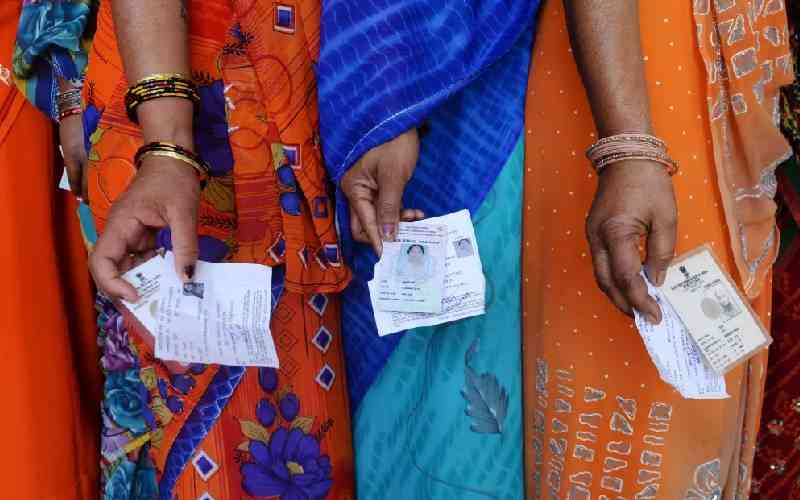The glue that binds Mt Kenya
By Daniel Waweru
NAIROBI, KENYA: The Kenyan Historian, ES Atieno-Odhiambo once claimed of Kenyan politics: ‘The future of ethnicity is robust, the career of nationalism ended at independence, and the future of democracy, like the arrival at destination of the matatu transport system in Kenya, remains uncertain.’
Similar forms of pessimism are widely available, especially in the wake of the election. There’s a general feeling that Kenya’s achievement hasn’t matched its potential and that the gap is permanent. Ethnicity is the main reason proposed for this pessimism. Its power to befuddle seems to arise from its immunity to explanation.
I’ll attempt to explain Kenyan ethnic voting on the assumption that attempts to stop it will go better if we understand why it happens.
Let us start with a crude, though very popular, theory of our ethnic voting. It is said that people vote ethnically because of their identity; that poor people are more likely to vote ethnically than the rich, and that voters vote ethnically in the hope of taking a slice of the national cake.
To see why that theory might be wrong, let us re-consider voting behaviours. First, we should assume that voters are roughly reasonable. Second, notice that naked appeals to ethnic identity can’t win a national election because no Kenyan ethnic group is large enough to win the necessary majority and naked appeals to ethnicity will turn off most other ethnic groups.
Third, if voters are rational, then explanations of their behaviour should reflect it. Fourth, rational voters vote either to gain or keep a benefit or to avoid or minimise a loss. If you have Sh100, it is very likely that you will vote to keep or increase it or else to ensure that you lose as little of it as possible.
In ‘Tribalism as a Minimax-Regret Strategy’, Mwangi Kimenyi and Gutiérrez Romero argue persuasively that ethnic voting in Kenya is defensive: A voter acts to minimise the chance of the worst expected result. Voters look at their options, and pick their worst option. They will then pick the candidate who can best prevent their worst option from materialising.
Suppose there are two candidates, Tumbo and Kubwa. Tumbo promises to give you Sh50 and Kubwa promises to take Sh50 from you. You will vote for Tumbo, but only because you hope to minimise your chance of losing Sh50 not because you actually believe Tumbo will give you an extra Sh50.
A defensive vote is not the same as a negative vote. Suppose that all the candidates in an election will increase
Sh100 bob by varying amounts. Tumbo promises to give you Sh100, and Kubwa Sh75. Then, the worst expected result of your vote still leaves you Sh75 better off, because you still have more than the Sh100 you had before the election.
In that situation, even if you vote to minimise the chances of your worst outcome, you will not have voted negatively, because you will have voted for some gain or other. That leaves us with a proper negative vote — where you vote purely to avoid or minimise an expected loss.
The basic claim of my new improved story of ethnic voting is that Kenyan voters are negative voters because they vote to avoid an expected loss for their ethnic group.
Some general evidence in support of the story may be found in Kahneman’s discovery of loss aversion in behaviour. Roughly speaking, when faced with a choice of a loss or gain of equal size, people will prefer to avoid the loss rather than seek the gain.
Stay informed. Subscribe to our newsletter
An example: You will spend more time and trouble to avoid losing the Sh100 you already have, than you will to gain Sh100 that you don’t have. If people prefer avoiding a loss of Sh100 to gaining Sh100, then their motivation to avoid the loss is at least as strong as their motivation to go for the gain.
The conclusion seems to be that, generally, the motivation to avoid losses is at least as strong as the motivation to seek a gain. It is this motivation which eems to underpin Kenyan voting behaviour.
Kimenyi and Gutiérrez Romero’s theory must count as an instance of both defensive and negative voting, since their result is achieved under the remarkably unrealistic assumption that Gikuyu voters in 2007 did not expect to be discriminated against under an Odinga government.
If they’re able to prove their result on such minimal assumptions, then that result ought to be strengthened once the more realistic assumption that at least some Gikuyu voters in 2007 expected to be discriminated against under an Odinga government is put in place.
All else equal, raising the potential loss raises the probability that the voter will act to prevent or minimise it.
The new story tells us that ethnic voting is negative: When voters vote for a Presidential candidate of their ethnic ty, they’re voting to avoid or minimise the loss they expect were a candidate of another tribe to take power. And since voters vote to avoid a loss, the greater the expected loss, the likelier an ethnic vote.
We should prefer this theory to the crude popular theory presented earlier. To see why the crude theory is unsatisfying, remember that it claims that the poorer you are, the more likely you are to vote ethnically. But this conflicts with survey evidence showing that better-off Kenyans are likelier to vote ethnically. The new story can explain why richer Kenyans are more likely to vote ethnically: They have more to lose.
The crude theory told us that voters vote ethnically because of their identity. When they step into their polling station, they suddenly remember their home language. Here, the crude theory again conflicts with observation.
Even Kenyans do not uniformly identify with their ethnic group. Women often identify less with their ethnicity than do men. Yet men and women vote ethnically at similar rates.
The new, improved story can explain this. If all members of an ethnicity can be convinced that they face serious losses just because they’re members of that ethnic group, then, regardless of how little they identify with their ethnicity, they can be convinced to vote ethnically.
The crude theory also told us that voters vote ethnically in the hope of gaining a piece of the national cake. But, especially for the larger ethnic groups, voters know before they vote that there is very little chance of even a small slice of the national cake reaching them. Yet they still vote ethnically.
The new improved story tells us that, because Kenyans are very averse to losses, they will still vote for a candidate who can promise to help them keep what they have, even if he cannot promise to bring them any extra cake.
The new theory has one last advantage over its competitor. It suggests a path out of ethnic voting. If the most motivated ethnic voters are the male.
 The Standard Group Plc is a
multi-media organization with investments in media platforms spanning newspaper
print operations, television, radio broadcasting, digital and online services. The
Standard Group is recognized as a leading multi-media house in Kenya with a key
influence in matters of national and international interest.
The Standard Group Plc is a
multi-media organization with investments in media platforms spanning newspaper
print operations, television, radio broadcasting, digital and online services. The
Standard Group is recognized as a leading multi-media house in Kenya with a key
influence in matters of national and international interest.
 The Standard Group Plc is a
multi-media organization with investments in media platforms spanning newspaper
print operations, television, radio broadcasting, digital and online services. The
Standard Group is recognized as a leading multi-media house in Kenya with a key
influence in matters of national and international interest.
The Standard Group Plc is a
multi-media organization with investments in media platforms spanning newspaper
print operations, television, radio broadcasting, digital and online services. The
Standard Group is recognized as a leading multi-media house in Kenya with a key
influence in matters of national and international interest.









